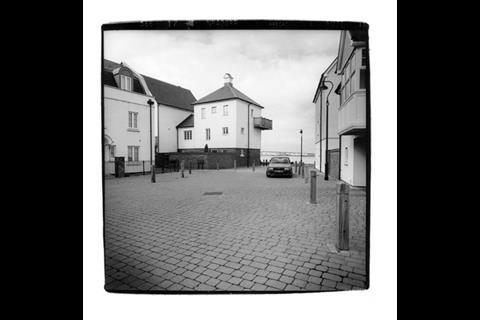After 20 years of dither, it’s just possible that things are looking up for the biggest regeneration project of all time: the Thames Gateway. On the eve of the Thames Gateway Forum, David Blackman looks at how vital elements of the scheme are finally falling into place, and Julian Anderson presents a photographic elegy to a landscape on the point of change
The Thames Gateway hype machine moves up another notch when the Thames Gateway Forum conference opens its doors next week. But few of the delegates gathering at Excel in London’s Docklands will know that it is 20 years since the concept was dreamt up.
What has now turned into an industry began life between the covers of a dry agenda paper at a 1987 meeting of a now defunct regional planning body. The report presented to a Serplan committee recommended that the 40 miles from the East End of London to the North Sea should be designated a vast regeneration zone known as the East Thames Corridor. The name Thames Gateway came later – coined by Michael Heseltine in his second coming as environment secretary during the early 1990s.
So, how does the man who drew up that 1987 report feel about how his idea has shaped up? Martin Simmons, who now lives in semi-retirement in rural Kent, notes with commendable understatement that “it has taken a long time” for the gateway to get off the ground. “It’s jolly good that governments, both Conservative and Labour, have thrown their weight behind the gateway, but it’s very disappointing that it’s taken as long as it has and there’s still a long way to go.”
Progress has been painfully slow. Working parties, strategies and studies have come and gone. With the exception of the Docklands area itself, not much happened on the ground. “For the first 10 years or so, all we were doing was talking about it, there was not a lot of doing,” says Alan Cherry, chairman of Countryside Properties, which is heavily committed to the area. Nigel Smith, chairman of the Royal Institution of Chartered Surveyors regeneration E E panel, agrees: “We have had lots of policy and studies, but not much priority in terms of money being spent.”
While the gateway grabs the headlines, more is happening in relatively humdrum locations such as Milton Keynes. David Birkbeck, director of Design for Homes, says: “Everybody talks about the gateway and yet nine out of 10 housebuilders, if they were given the chance, would go for Milton Keynes or Northampton.”
Figures collated by the National Audit Office earlier this year show the number of homes being built in the gateway has not increased as fast as in the rest of the South-east. The report calculates 12,500 homes would need to be built each year over the next decade to meet the government’s target of 160,000 new dwellings across the area by 2016. This is twice as many as are now being delivered. It is also said that if current building rates across the gateway continue, 95,000 homes would be complete by 2016, just over half the government’s target figure.
The gateway investment plan, which is finally due to be launched at the Thames Gateway Forum after two years of gestation, shows the picture is not improving (see graph, page 32). The number of completions barely rose in 2005-06, the last year for which figures are available. Infrastructure remains critically important, according to Birkbeck. “You can’t get London values unless you get the transport infrastructure.” People able to afford high salaries will not put up with a long commute.”
Still, the past year has seen a few key pieces of the gateway puzzle fall into place. International services have begun running on the Channel Tunnel Rail Link, through Ebbsfleet in Kent and Stratford. Within two years, bullet trains will be running commuter services from Ebbsfleet to London St Pancras, bringing the station within 20 minutes’ travelling time of central London. Last month saw funding approval for the long-delayed Crossrail, with a spur running into the south-east London section of the gateway.
Go-ahead for the Thames Gateway bridge still depends on the outcome of a second public inquiry. But on a brighter note, several flagship projects have seen progress. Bellway has secured outline consent for its 8,500 home joint venture development with English Partnerships at Barking Reach. Land Securities has won detailed consent for its Ebbsfleet scheme after concluding a groundbreaking Section 106 agreement with the Kent Thameside Delivery Board. Also at Ebbsfleet, Countryside has begun work on Springhead Park, the first phase of the giant scheme it is developing with Land Securities.
The place changes from one week to the next. We are changing the website wording from will or should or could to is and has
Michael Ward, Kent Thameside
“The whole of the gateway is looking a lot more deliverable than it has at any time in the past,” says Countryside’s Cherry. Michael Ward, chief executive of Kent Thameside delivery board, says: “When I show people around, the place changes from one week to the next.” The changes hit home recently when the board revamped its website. “We are changing the wording from will or should or could to is and has,” he says.
The opening of the CTRL is having an impact on the wider north Kent area. Developer David Taylor, who has been shortlisted for a project on Margate seafront, says he would never have considered developing in the far-flung seaside town before the fast rail came on stream. And while big ticket infrastructure items such as CTRL grab the wider world’s attention, smaller-scale interventions matter, too, he says, pointing to Dartford’s Fast Track. The area’s guided bus network is being upgraded to tie in with the opening of the station at Ebbsfleet.
So is all this activity lifting private sector confidence? Taylor says the gateway is “nearly” at the point of becoming a self-sustaining project with its own momentum. Sunny Crouch, a non-executive director of the Thurrock Thames Gateway Development Corporation, shares Taylor’s analysis. She’s bullish about the gateway’s prospects: “The major financial institutions all regard the gateway as an area of investment and opportunity and all have somebody whose job is to put money into the E E gateway,” she says. “There’s a lot of private sector appetite for going anywhere where the government is going to put its investment.”
But investors need continued evidence of political commitment, says Taylor, which is why the government’s investment framework matters. The omens, according to those who have seen draft copies of the plan, are not encouraging. The draft lists a series of priority projects in each area, but few cash commitments.
RICS’ Smith argues that it is time for more than a wish list. “The government’s been talking a good game, but it needs to put its money where its mouth is.” Nigel Kersey, director of the Campaign to Protect Rural England’s London branch, agrees: “We’ve had enough strategies; we want a serious commitment of money on a site by site basis. The question is, when we are going to get a properly costed delivery plan?”
It is not just the government that needs to start delivering, some believe. Kent Thameside’s Ward says developers need to step up to the plate too in his area, now that the infrastructure is slotting into place. “The two years between the opening of the international station and the domestic services is going to be absolutely critical,” he says. When domestic services start running in 2009, it will be vital to have both homes and workplaces in the area.”
The joker in the pack, of course, is how the housing market performs. Ward suggests intervention may be necessary. “The government will probably have to have a significant role in flagship projects to keep housing supply moving,” he suggests. Former housing minister Nick Raynsford thinks the delays may have a silver lining. “We have to get a real change in the quality of development. If we go on with the sort of pattern that we have had in the past, we would have a lot of poor quality sheds and we would not have got the quality of investment to transform the area.”
Even 20 years is a short time when looking at a project like the gateway, he says. “It’s redressing 300 years of history… and that can’t be done in a couple of decades.”
Downloads
Source
RegenerateLive


































No comments yet